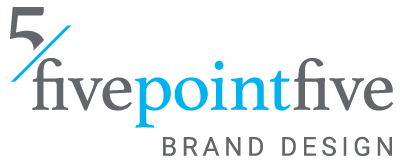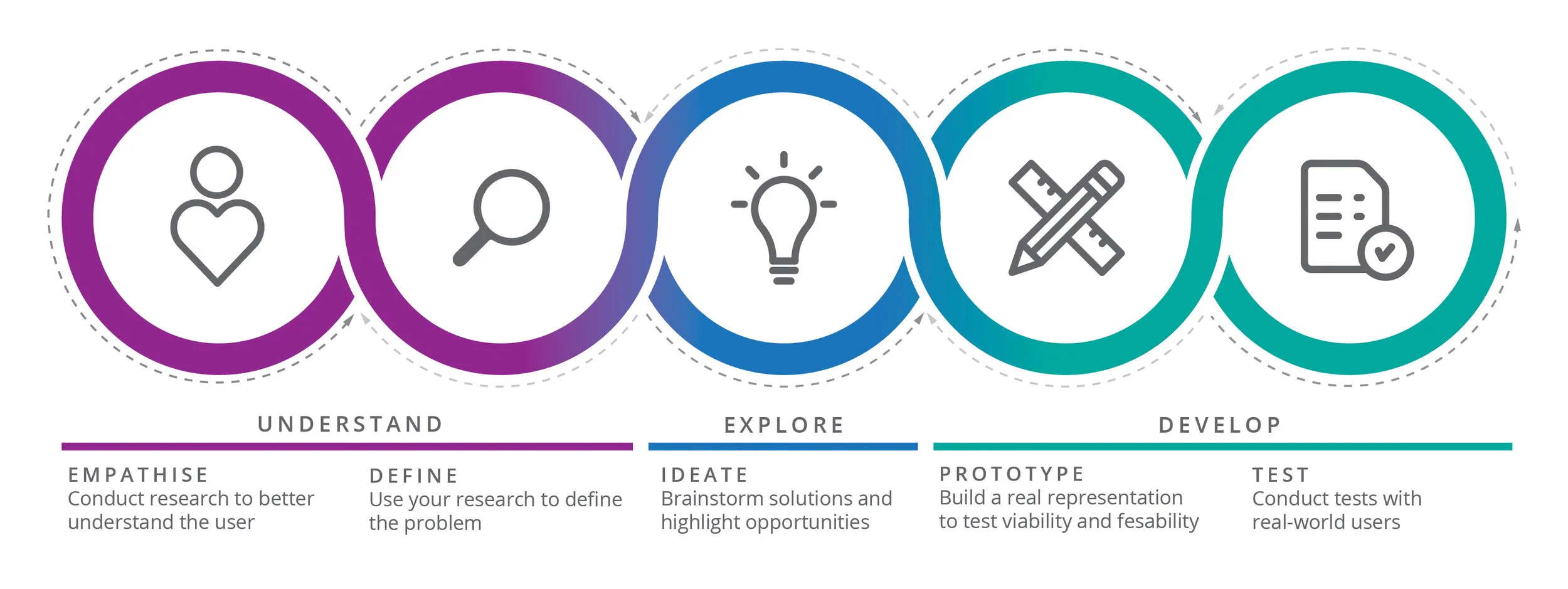The 5 Steps of Design Thinking
An introduction to the methodology used by innovation firms, government entities, and organizations from startups to Fortune 100 companies.
If you have been keeping up with our blogs; you might remember that I wrote a blog on Design Thinking some months ago to briefly introduce the methodology to business owners and other business leaders. I mentioned that I would write a second blog post with a more in-depth explanation of the phases and the topic in general, and here it is. You can find the first blog here.
To briefly introduce Design Thinking, I will first tell you what it is not. It is not a tool or process used ONLY in the design industry or only by designers. Design Thinking is a methodology developed by designers and innovators looking for a systematic process to solve complex problems. It is what the design industry calls a human-centered design (HCD) system that integrates a human perspective throughout the problem-solving process.
Design thinking has existed since the 1960s, but it has taken shape and grown in popularity over the past two or three decades. The innovation firm IDEO and its founder, David Kelly, have been accredited as the creators of Design Thinking, and today, this methodology has taken root in some of the world’s largest companies, like IBM, Toyota, Apple, and Bank of America.
The design thinking process sometimes varies depending on who is using it. Some people use three or four steps or phases, and some use up to seven. The most popular framework is a five-step process. Still, the project can also dictate the number of steps and not necessarily by the person or team. Regardless of the number of steps you use, all Design Thinking embodies the same principles—Empathize, Define, Ideate, Prototype, and Test.
The five steps below are described in terms of designing a product or service, but the Design Thinking process can be utilized in almost any way imaginable to solve complex problems.
Empathize:
Design Thinking centers on developing an understanding of or empathy for the consumers of a particular product or service. In this stage of the design thinking process, you want to understand the consumer’s needs and how they relate to your offering. We also begin questioning assumptions, conducting user interviews, and gathering data through qualitative and/or quantitative research. This is all done to better understand the consumer and their needs.
When you truly understand the consumer’s needs and work through the other phases of the Design Thinking process, you may discover the need to change or alter your product or service. If you have a preexisting product or service, you may find yourself needing to make adjustments to it, but be patient and go through the entire process, letting the information you uncover influence any alterations you may make to it.
Define:
During the define stage, you will use the information you have gathered and define the core problems. You are seeking to define the consumer’s problem based on how it affects the people involved and not from the perspective of your business’s wishes and desires.
To create a formal problem statement, you will want to analyze all the data you have collected in the empathize stage. This statement will define the user, state the need, and provide insight into the problem. These are all things that you should have learned in the empathize stage.
Ideate:
Now that you have a firm understanding of the consumer’s problem, it is time to “think outside the box” to create innovative solutions and choose to look at the problem in a new way. Any technique you use, such as brainstorming or SCAMPER, will stimulate free thinking. This stage allows you and/or your team to brainstorm ideas and create a collection of solutions.
At the beginning of this phase, you will want to generate as many ideas or solutions to the problem as possible. After generating a list of ideas, you can narrow it down by eliminating some of the weaker or faulty solutions. After you have narrowed down your solutions, it’s time for the prototype and testing phases.
Prototype:
At this point, you and your team can create some scaled-down versions of products or specific features that you have worked to develop. The prototype and testing phases work closely together, and you may often go back and forth between the two. This phase also helps test the validity of the solution. It will be very experimental, and its goal is to identify the most likely solutions for the problem outlined by the above phases and eliminate or adjust solutions that may not be viable or feasible. Each solution is tried, discussed, and tweaked to develop a version to present to your consumer.
You might think of a prototype as a material object, but it is just as likely to be an operational process or a service-based solution for a client. The prototype means you have gathered, organized, and/or created something to test with real consumers.
Test:
In the testing phase, you go to a selected group of people who will need and/or want your product or service but have just been involved in the process. Once in the testing phase, you must be open-minded and learn from user feedback. It will be vital to the process and your success that this phase helps shape and develop your product or service. Suppose you want to develop an offering that is highly adopted by the market and is passionately talked about by the consumer. In that case, you have to listen to the consumer’s input.
Once you start getting feedback from testing, it is common to go back to the prototyping phase or even earlier in the process and make adjustments to finetune your offering as much as possible. Design Thinking is not a linear process; you may start somewhere in the middle, like ideating or prototyping, and then jump to the beginning to Empathize. However, getting information from all the steps is imperative to make the best offering that will be successful in the marketplace. It would be easier if design thinking fit in a nice neat little package, one stage always leading directly to the next. However, we must stay flexible, as in all things creative.
Another thing to note is that Design Thinking is not always about goods and services; you can use it to develop business processes, business models, and virtually anything that needs solving that involves people.
The benefit of using this process is that your solution will be well thought out. You will have found several ideas, tested them, and implemented something that will have your confidence and complete approval.
If you are looking for a way to solve complex problems or test the viability and feasibility of a solution, consider using this process. If you would like more information on design thinking or would like us to put on a design thinking workshop with your team, contact us at nathanb@5point5.co.



